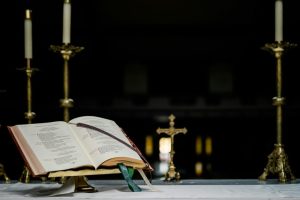Seeking input on marriage and family life, Pope Francis has decided to consult the experts.
If Pope Francis asked you whether divorced and remarried Catholics should be able to receive communion, what would you say? What if he asked you about the lesbian couple in the parish who sends their children to the local Catholic elementary school? Or about your son who is planning to marry his long-time girlfriend but in the meantime shares a condo and a dog with her?
The election of a South American pope has so far proved only the beginning of the shake-up that last year’s papal conclave set in motion. Many suggested that the choice of Jorge Mario Bergoglio was specifically directed toward shifting more authority to local bishops and bishops’ conferences—the presumption being that the Curia had too much power.
So when the pope announced an extraordinary synod of bishops on marriage and family life to be held in October 2014, there was great expectation for a gathering that would involve actual debate, and where the outcome would not be predetermined by the synod’s Vatican handlers.
But Pope Francis, it seems, has more than consulting the bishops in mind; he is also asking for input from local clergy and laity on issues involving marriage, family planning, and even same-sex partnerships. Some bishops’ conferences—notably that of England and Wales—have even posted the Vatican questions online for review and response, on SurveyMonkey, no less. (The U.S. bishops have yet to follow suit.)
The questions themselves are refreshingly frank. It’s clear that the synod committee actually wants to know whether Catholics accept church teaching on a number of issues, from the definition of marriage according to “natural law” to Humanae Vitae’s ban on most forms of contraception.
Even more, the questions show remarkable pastoral sensitivity about people’s lives, with particular emphasis on helping families practice the faith as a “domestic church.” Curiosity abounds in questions about the percentage of couples that cohabit before marriage or who have been previously divorced. Of same-sex couples with children, the questionnaire asks, “How do the particular churches attempt to meet the needs of the parents of these children to provide them with a Christian education?”
Overall, the questionnaire presumes the presence of families that don’t fit the model proposed in Catholic teaching and even intimates openness to change in making a place for them. An intriguing question about the annulment process—“Could a simplification of canonical practice in recognizing a declaration of nullity of the marriage bond provide a positive contribution to solving the problems of the persons involved?”—suggests that some reform is already under consideration.
Consulting the faithful on these matters is not without danger, as Pope Paul VI learned from the now infamous commission on birth control, which counseled a change in church teaching on the matter. When Paul VI left the teaching unchanged, he alienated a generation of married Catholics and widened a rift between church leaders and the faithful about sexuality that has only expanded in subsequent decades.
Frankly, the pope and the bishops may not like what they hear from the faithful on these matters. Even if the pope is inclined toward a more generous approach to couples in so-called “irregular relationships,” the rest of the world’s bishops may not be.
At the same time, having the courage to ask significant questions of Catholics who live the realities of contemporary family life is a major step toward a church that takes seriously the discernment of all its members. The announcement in late October that the Pontifical Council for the Laity will be “upgraded” to a Vatican congregation—joining those for bishops, clergy, and religious—is another signal that the voices of the vast majority of Catholics are going to get a greater hearing. Whether they will affect the course of church teaching and practice remains to be seen.
This article appeared in the January 2014 issue of U.S. Catholic (Vol. 79, No. 1, page 8).
Image: iStock/adventtr














Add comment